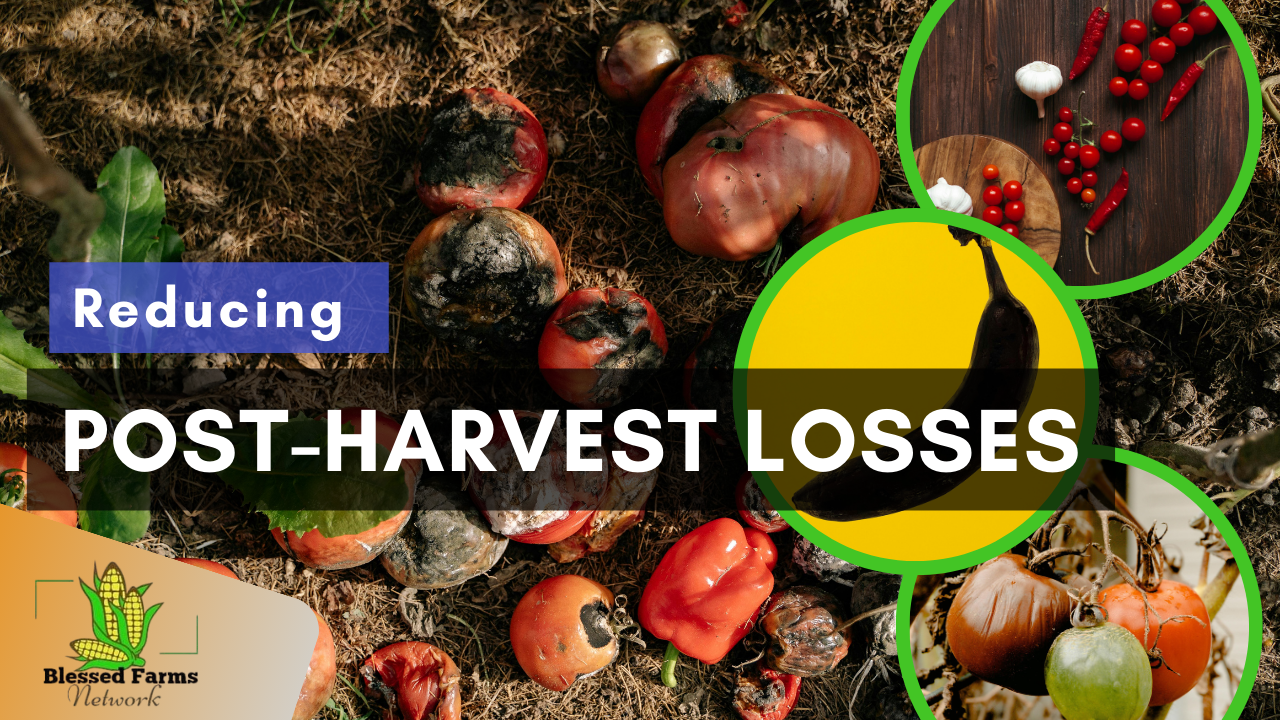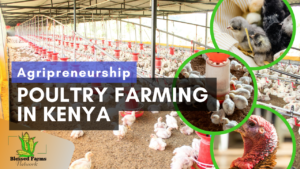Introduction
Impact-Site-Verification: abfbb1e4-6470-4547-ab1b-37470ad943ab
According to a study commissioned by the FAO, over 1.3 billion tonnes, accounting for one-third of food produced for human consumption, are lost through post-harvest handling each year. Post-harvest loss is defined as edible food mass (quantity) or nutritional value (quality) of food intended for human consumption that is lost and doesn’t reach the intended use; consumption. These losses occur from the point of harvest through processing, marketing, preparation, and consumption, and is caused by poor handling, lack of market access, and lack of sustainable packaging for farmers. Post-harvest losses in Kenya are a huge issue that affects almost all value chains, with farmers going through extensive losses that not only demoralize but also reduce the sustainability of their farming activities.
The post-harvesting losses that small-scale farmers in Kenya are experiencing can be linked to a lack of training in handling excess produce. Farming is a seasonal activity in Kenya, where there are seasons of excess and seasons of lack. An effective post-handling strategy, specifically through the utilization of sustainable packaging systems for farmers and better marketing strategies can reduce post-harvest losses in Kenya. This article aims to explore practical techniques that small-scale farmers in Kenya can use to reduce losses through innovative storage techniques, sustainable packaging, and effective marketing strategies.
The Impact of Post-Harvest Losses in Kenya
There have been major improvements in the production process of food in the world. It can be stated that global food production is at its peak currently, with continued innovations and technologies proving that it is even possible to go higher. But even with the increase in production, there are still food insecurities in most countries, with millions of families sleeping hungry worldwide. The issue of food insecurity is quite rampant in Kenya, with over 51% of families lacking enough food. The rate of malnutrition in the country is quite high, with about 29% of children in rural areas and 20% of those in cities experiencing impaired development due to malnutrition. The high rate of HIV, about 1.5 million people, is also a major issue. Other than the increasing population, a major cause of food insecurity is the losses experienced after harvesting. Apparently, one-third of all food produced worldwide is either lost or wasted, equivalent to 1.3 billion tons of loss yearly.
Post-harvest loss is also a major issue for farmers in Kenya. According to the World Food Program research done in 2023, about 40% of crops harvested in Kenya are lost due to post-harvest losses. This loss accounts for up to $500 million in financial losses. The loss is experienced in almost all value chains, with the maize value chain recording a 16.7% loss and a 4.5% loss in the diary value chain. The horticulture value chain is considered the most affected due to the perishable nature of these produce. The horticulture value chain accounts for about 50% loss.
Post-harvest losses are caused by different things starting from the point of harvest to the point of consumption. A late harvest could leave the products prone to pests like insects, birds, and rodents, and attack from mold. Overexposure to the sun can leave it too dry making it brittle and prone to cracking during threshing and milling. After harvesting, products like grains are dried and taken to threshing which can lead to broken grains that encourage infestation by insects. Other causes of post-harvest losses include limited infrastructure for proper storage, lack of sustainable packaging solutions for farmers, poor transportation infrastructure, and difficulties accessing competitive markets.
Due to these issues, farmers experience huge losses, which further affect the food security of the country. While increasing food production is a viable solution to deal with these issues caused by food insecurity, it is necessary to ensure even the quantity currently being produced is managed well to reduce loss. Preventing post-harvest losses will ensure that there is increased availability of food without requiring additional resources or burden on the environment. This process can only happen when we develop strategies to manage post-harvest losses.
Strategies to Manage Post-Harvest Losses
Effective post-harvest handling assures farmers of increased produce, and thus more profits. Post-harvest handling starts from the harvesting season, to on-farm storage, transportation strategies, and pre-sale agricultural marketing strategies.
1. Proper Harvesting Techniques
Post-harvest losses in Kenya can considerably be reduced through timely and careful harvesting techniques that will ensure that there is reduced mechanical damage to the crops. The time for harvesting is dependent on the degree of maturity of the crop, and thus it varies. Cereals and pulses have a distinct maturity time for the seeds, ears, and stalks, and this should be considered as it affects the successive operations of storage and preservation.
As a farmer, it is important to determine the degree of crop maturity to ensure that each crop is harvested at the right time. Farmers should also keep up with the weather to ensure that poor weather doesn’t hinder the operations and functionality of harvesting machines and people. Further, rainy weather can lead to increased moisture content in the harvested products. Proper harvesting tools and equipment should also be used where there is minimal bruising and crushing, and the harvested crops placed in the appropriate containers like lightweight baskets or soft-lined containers which will reduce pressure on delicate produce.
2. On-Farm Storage Solutions
Advancements have been done in this field to ensure that farmers can store their produce for longer periods with minimal losses and waste. Some of these technologies include:
A. Hermetic Bags
these are airtight bags that are used mainly for grains in that they prevent pests’ survival and development of mold. The use of hermetic bags has been proven to be successful in reducing losses by up to 50%. PICS (Purdue Improved Crop Storage) bags allow farmers to reduce reliance on chemical treatments while preserving the grains for longer without losses.
B. Solar Dryers
the technology of reducing the moisture content of crops before storage has been proven to be effective in reducing post-harvest losses in Kenya. Solar driers are mostly used for crops like leafy vegetables, peppers, and tomatoes. They increase the shelf-life of these crops. The use of solar dryers to preserve food will be discussed in another article.
C. Zero-Energy Cooler
This is a simple, cost-effective system that uses clay or bricks. The technology uses evaporative cooling to maintain low temperatures allowing for the preservation of greens and fruits.
3. Transportation Innovations
Farmers also experience losses during the transportation of their crops from their farms to the point of consumption or sale. Innovative transportation systems will reduce losses during transit.
A. Insulated Crates
This is an effective method for transporting fruits and other crops that can easily be bruised or damaged due to pressure. Unlike traditional sacks, insulated crates prevent bruising and better air flow thus limiting contamination. Currently, insulated crates are used for the transportation of mangoes and avocados.
B. Cold-Chain Transport
This is a technique not commonly used in Kenya due to its cost. Large companies like in the dairy industry, though, utilize them to transport perishable goods like milk, meat, and fresh produce. The cold chain system reduces spoilage and extends the time reducing losses.
4. Pre-Sale Processing
An effective agricultural marketing strategy is pre-sale processing to enhance the produce and thus get maximum income.
A. Cleaning
Removing dirt and residue from produce makes products more appropriate for marketing while still reducing losses.
B. Sorting and grading
Crops should be categorized according to size, ripeness, and quality to ensure consistency.
C. Packaging
Packaging is necessary to create a polished look
Pre-sale processing not only helps to reduce waste but also adds value, enabling farmers to command better prices and access diverse markets, including supermarkets and restaurants.
Sustainable and Effective Packaging for Storage and Transport
A major cause of post-harvest losses is a surplus in production. In a country where most value chains do not have a centralized marketing strategy, farmers must develop innovative ways of keeping the surplus for future use, while still maintaining the quality and nutritive value. This can be done by using effective packaging techniques.
Packaging is the process of enclosing or protecting products for storage, transport, or sale using materials that are designed to preserve the quality and safety of the content. When farmers produce more than what can be sold immediately effective packaging ensures that the excess is preserved for long periods, minimizing spoilage and waste. Packaging technologies allow farmers that store produce for home use, allowing for a consistent supply of food throughout the year.
Some sustainable and effective packaging technologies that farmers could use include:
- Innovative packaging materials like biodegradable or compostable materials.
- Vacuum and modified atmosphere packaging
- Reusable packaging like crates and bins for transport
Innovations to Reduce Post Harvest Loss
Different companies have developed innovative techniques to reduce post-harvest loss in Kenya. These companies are leveraging technology and creative solutions to tackle the persistent issue of post-harvest loss in Kenya. They aim to not only considerably reduce loss but also increase the income of farmers while managing the environment.
A company called BioAfriq Energy has developed a solar hybrid dehydrator that is an advancement to the normal solar dehydrator. Their innovation uses biomass waste as an alternative energy source through the process of gasification. This system can be used by farmers throughout the year, not only when there is sun, further it produces organic fertilizer and cleaner air. This revolutionary solar hybrid dehydrator provides a multifaceted approach to the energy challenges thus supporting sustainable agriculture and providing farmers with an efficient method of preserving surplus harvests.
Another company named Agri-business Solutions Ltd is focused on the horticulture-avocado value chain, where they collaborate with farmers to collect rejected avocados. They employ a zero-waste circular economic model where the non-export avocado is turned into crude avocado oil and briquettes. This project is seen to reduce the annual loses considerably.
Botanic Treasures is a company that specializes in various agricultural products like turmeric, ginger, and hibiscus and aims to minimize post-harvest loss along these value chains. The company uses a combination of innovative dryers and digitized platforms that combine an app that enhances quality control.
These are among the many companies that exemplify the potential of innovations and collaboration in transforming the agricultural value chain in the country. While their mission is to produce post-harvest losses, their innovations have created value for both rejected and surplus produce and support farmers earn more income. They have improved livelihood while still contributing to environmental sustainability and food security.
Conclusion
Any farmer that seeks to increase their input and profits, need to adopt post-harvest handling techniques that will reduce losses. Further, reducing post-harvest losses is a critical step towards achieving food security, environmental sustainability, and economic empowerment for Kenyan farmers. With nearly 40% of the country’s harvested crops lost annually, innovative solutions in packaging, storage, and marketing are essential to mitigate these challenges. Sustainable packaging options, effective storage technologies, and innovative strategies from companies like BioAfriq Energy, Agri-business Solutions Ltd, and Botanic Treasures showcase the transformative potential of technology and collaboration in the agricultural sector.
By adopting these solutions, farmers can preserve their produce, reduce waste, and gain better access to markets, ultimately increasing their income and enhancing Kenya’s food systems. Tackling post-harvest losses not only ensures a more sustainable future for agriculture but also strengthens the livelihoods of millions of small-scale farmers while addressing the persistent issue of food insecurity in the country.





